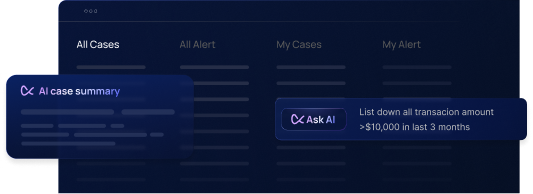Just recently, Lithuania's central bank fined Revolut a record €3.5 million for significant AML compliance breaches. According to the central bank, the fintech giant failed to properly monitor business relationships and operations, which resulted in its inability to consistently identify suspicious monetary transactions.
This fine underscores a growing regulatory trend. While real-time transaction monitoring is essential, but on its own, it’s no longer sufficient to ensure AML compliance in today’s complex and fast-moving financial environment.
In this article, we explore why fintechs and financial institutions must move beyond siloed transaction monitoring and embrace an integrated AML framework that includes automated risk scoring and modern case management.
1. The Limitations of Transaction Monitoring Alone
Transaction monitoring systems are designed to detect suspicious activity based on predefined rules and thresholds. These systems are foundational to any AML strategy. However, relying on transaction monitoring alone can lead to:
- High false positive rates, overwhelming compliance teams
- Delayed detection of suspicious activity
- Limited visibility into customer behavior and risk over time
In Revolut’s case, the central bank pointed to failures in "monitoring business relationships," suggesting the gaps weren’t just about transactions, but about context. Who is the customer? What’s their risk profile? Has their behavior changed?
Without dynamic risk assessment and investigative follow-through, transaction monitoring becomes a blunt tool.
2. Why Risk Scoring Must Be Embedded
Customer risk scoring allows institutions to continuously evaluate the level of risk associated with each user or entity. This goes far beyond a one-time KYC check:
- Risk evolves: A user might start with a low-risk profile but engage in higher-risk activity over time
- Geography and behavior matter: Dynamic scoring captures jurisdictional risk, transaction types, frequency, and more
- Better prioritization: Helps compliance teams focus on high-risk cases instead of being buried under low-risk alerts
By integrating automated, configurable risk scoring into your AML program, you can detect patterns that transaction monitoring alone would miss.
3. Modern Case Management Closes the Loop
Detecting anomalies is only half the job. Once suspicious behavior is flagged, the ability to investigate, document, escalate, and report efficiently is critical.
A modern case management system enables:
- Consolidation of alerts into unified investigations
- Collaborative workflows across compliance teams
- Detailed audit trails and report generation
- Faster SAR filing with structured documentation
In Revolut’s situation, deficiencies in control likely extended to how investigations were handled post-alert. Without strong case management, even detected risks can fall through the cracks.
4. The Case for an Integrated AML Platform
Flagright provides a unified, AI-native AML compliance platform that combines real-time transaction monitoring, dynamic risk scoring, and intelligent case management in one no-code solution. This integrated approach:
- Reduces false positives with contextual detection
- Automates risk assessment and scoring based on real-time behaviors
- Enhances decision-making with AI-native investigative tools
- Improves audit-readiness and regulatory reporting
In an era of increasing regulatory scrutiny, like we saw with Revolut, fragmented systems simply can’t keep up. An integrated AML platform not only reduces compliance risk but also drives operational efficiency.
Conclusion
The Revolut fine is a stark reminder that regulators are raising the bar. A basic transaction monitoring system is no longer enough to protect your business from fines, reputational damage, and missed threats.
To build a resilient AML framework, financial institutions need to move toward integration, bringing together transaction monitoring, risk scoring, and case management into a seamless compliance infrastructure.
At Flagright, we help fintechs and financial institutions modernize their AML operations with a modular, no-code solution built for real-time risk detection, automated investigations, and seamless compliance workflows.
Our customers around the world trust Flagright to strengthen their compliance posture, reduce operational burden, and stay ahead of regulatory expectations, and once you experience the platform firsthand, you'll understand why.
Ready to future-proof your compliance stack? Request a demo today and see Flagright in action.




.svg)























